AMD's Radeon HD 5870: Bringing About the Next Generation Of GPUs
by Ryan Smith on September 23, 2009 9:00 AM EST- Posted in
- GPUs
Eyefinity
Somewhere around 2006 - 2007 ATI was working on the overall specifications for what would eventually turn into the RV870 GPU. These GPUs are designed by combining the views of ATI's engineers with the demands of the developers, end-users and OEMs. In the case of Eyefinity, the initial demand came directly from the OEMs.
ATI was working on the mobile version of its RV870 architecture and realized that it had a number of DisplayPort (DP) outputs at the request of OEMs. The OEMs wanted up to six DP outputs from the GPU, but with only two active at a time. The six came from two for internal panel use (if an OEM wanted to do a dual-monitor notebook, which has happened since), two for external outputs (one DP and one DVI/VGA/HDMI for example), and two for passing through to a docking station. Again, only two had to be active at once so the GPU only had six sets of DP lanes but the display engines to drive two simultaneously.
ATI looked at the effort required to enable all six outputs at the same time and made it so, thus the RV870 GPU can output to a maximum of six displays at the same time. Not all cards support this as you first need to have the requisite number of display outputs on the card itself. The standard Radeon HD 5870 can drive three outputs simultaneously: any combination of the DVI and HDMI ports for up to 2 monitors, and a DisplayPort output independent of DVI/HDMI. Later this year you'll see a version of the card with six mini-DisplayPort outputs for driving six monitors.

It's not just hardware, there's a software component as well. The Radeon HD 5000 series driver allows you to combine all of these display outputs into one single large surface, visible to Windows and your games as a single display with tremendous resolution.
I set up a group of three Dell 24" displays (U2410s). This isn't exactly what Eyefinity was designed for since each display costs $600, but the point is that you could group three $200 1920 x 1080 panels together and potentially have a more immersive gaming experience (for less money) than a single 30" panel.
For our Eyefinity tests I chose to use every single type of output on the card, that's one DVI, one HDMI and one DisplayPort:
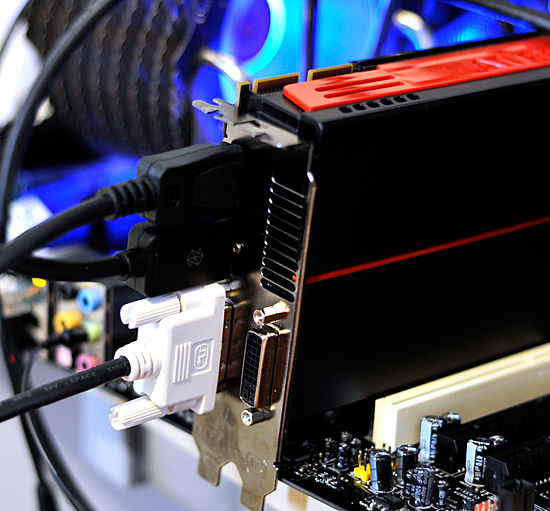
With all three outputs connected, Windows defaults to cloning the display across all monitors. Going into ATI's Catalyst Control Center lets you configure your Eyefinity groups:

With three displays connected I could create a single 1x3 or 3x1 arrangement of displays. I also had the ability to rotate the displays first so they were in portrait mode.

You can create smaller groups, although the ability to do so disappeared after I created my first Eyefinity setup (even after deleting it and trying to recreate it). Once you've selected the type of Eyefinity display you'd like to create, the driver will make a guess as to the arrangement of your panels.

If it guessed correctly, just click Yes and you're good to go. Otherwise ATI has a handy way of determining the location of your monitors:

With the software side taken care of, you now have a Single Large Surface as ATI likes to call it. The display appears as one contiguous panel with a ridiculous resolution to the OS and all applications/games:
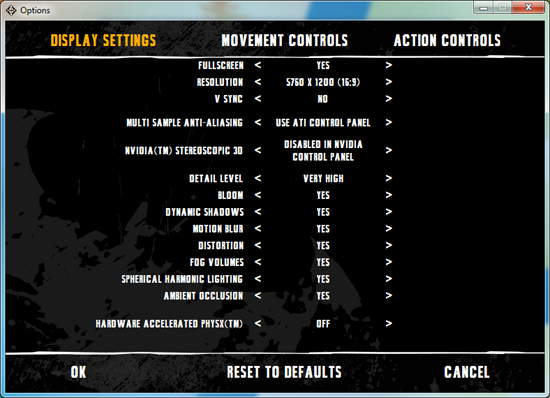
Three 24" panels in a row give us 5760 x 1200
The screenshot above should clue you into the first problem with an Eyefinity setup: aspect ratio. While the Windows desktop simply expands to provide you with more screen real estate, some games may not increase how much you can see - they may just stretch the viewport to fill all of the horizontal resolution. The resolution is correctly listed in Batman Arkham Asylum, but the aspect ratio is not (5760:1200 !~ 16:9). In these situations my Eyefinity setup made me feel downright sick; the weird stretching of characters as they moved towards the outer edges of my vision left me feeling ill.

Dispite Oblivion's support for ultra wide aspect ratio gaming, by default the game stretches to occupy all horizontal resolution
Other games have their own quirks. Resident Evil 5 correctly identified the resolution but appeared to maintain a 16:9 aspect ratio without stretching. In other words, while my display was only 1200 pixels high, the game rendered as if it were 3240 pixels high and only fit what it could onto my screens. This resulted in unusable menus and a game that wasn't actually playable once you got into it.
Games with pre-rendered cutscenes generally don't mesh well with Eyefinity either. In fact, anything that's not rendered on the fly tends to only occupy the middle portion of the screens. Game menus are a perfect example of this:
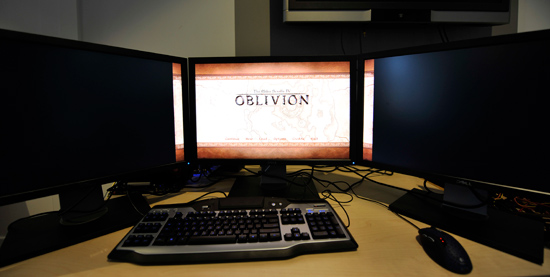
There are other issues with Eyefinity that go beyond just properly taking advantage of the resolution. While the three-monitor setup pictured above is great for games, it's not ideal in Windows. You'd want your main screen to be the one in the center, however since it's a single large display your start menu would actually appear on the leftmost panel. The same applies to games that have a HUD located in the lower left or lower right corners of the display. In Oblivion your health, magic and endurance bars all appear in the lower left, which in the case above means that the far left corner of the left panel is where you have to look for your vitals. Given that each panel is nearly two feet wide, that's a pretty far distance to look.
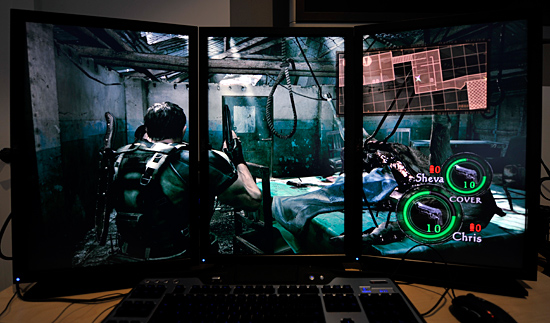
The biggest issue that everyone worried about was bezel thickness hurting the experience. To be honest, bezel thickness was only an issue for me when I oriented the monitors in portrait mode. Sitting close to an array of wide enough panels, the bezel thickness isn't that big of a deal. Which brings me to the next point: immersion.
The game that sold me on Eyefinity was actually one that I don't play: World of Warcraft. The game handled the ultra wide resolution perfectly, it didn't stretch any content, it just expanded my viewport. With the left and right displays tilted inwards slightly, WoW was more immersive. It's not so much that I could see what was going on around me, but that whenever I moved forward I I had the game world in more of my peripheral vision than I usually do. Running through a field felt more like running through a field, since there was more field in my vision. It's the only example where I actually felt like this was the first step towards the holy grail of creating the Holodeck. The effect was pretty impressive, although costly given that I only really attained it in a single game.
Before using Eyefinity for myself I thought I would hate the bezel thickness of the Dell U2410 monitors and I felt that the experience wouldn't be any more engaging. I was wrong on both counts, but I was also wrong to assume that all games would just work perfectly. Out of the four that I tried, only WoW worked flawlessly - the rest either had issues rendering at the unusually wide resolution or simply stretched the content and didn't give me as much additional viewspace to really make the feature useful. Will this all change given that in six months ATI's entire graphics lineup will support three displays? I'd say that's more than likely. The last company to attempt something similar was Matrox and it unfortunately didn't have the graphics horsepower to back it up.
The Radeon HD 5870 itself is fast enough to render many games at 5760 x 1200 even at full detail settings. I managed 48 fps in World of Warcraft and a staggering 66 fps in Batman Arkham Asylum without AA enabled. It's absolutely playable.
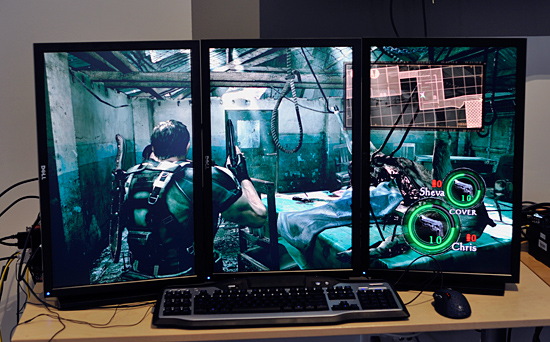










327 Comments
View All Comments
silverblue - Saturday, September 26, 2009 - link
I think you may have been much happier with a 512-bit interface which would result in nearly 2.5x the bandwidth of the 4890, however it remains to be seen whether it'd be a waste or not. Having said that, it could mean for slower GDDR5 thus reducing costs, but wouldn't it be far more problematic to incorporate the wider bus anyway?If ATI throw out such a card with a single GPU on it, a direct comparison with the 5870 (and nVidia's top cards at the time) will be inevitable. The extra bandwidth may be rather under-utilised for anything less than Eyefinity gaming or Crysis at max details ;)
Now all we need is AMD to come back at Intel with a domestic release of its Thuban die (or hurry up with Bulldozer, sheesh) and it'll be a very, very exciting time for people to upgrade.
SiliconDoc - Sunday, September 27, 2009 - link
I want to know how the pinout compares on the 5870 gpu to the 4870/90.Have they doubled the data pins, or is the data jamming in and jamming out, even at 4800mhz ?
Maybe that's why 512bit would help.
Perhaps faster data rate ram, needs also a wider data path, more pins, more paths in and out of the gpu.
I will check the overclock sites that have already posted on this matter.
JarredWalton - Sunday, September 27, 2009 - link
I would assume that the pin count on 5870 isn't radically different from 4870. Granted, we know what assuming can get you, but with the same interface width there's not much reason for it to get substantially more pins. A few changes for power leads to deal with having more transistors, and other minor tweaks are likely, but my bet would be it's within 10% of the pin count of 4870.PorscheRacer - Monday, September 28, 2009 - link
For all those people clamoring on about why ATI didn't go with a 512-bit memory controller I'm going to chime in here with some ATI 512-bit experience. If you're a sharp one reading this, you have already guessed that means I'm going to talk about the R600. Now you can hate the card all you want, but I quite enjoyed this card. First of all, in the R600 it was the last ring-bus. It was a true 512-bit, and large memory controller. I'm not certain on the amount, but I believe it owned about a quarter of the realstate on the die. That's a lot. It also was some of the cause for the chip running hot and why UVD was scrapped from that chip to save room.Now, to keep that 512-bit ring-bus fed, you needed to push large amounts of data to it. The more you increased system bandwidth, the faster the card would be in any task. I've run hundreds of benchmarks over the years and I'm pretty sure Jared and Anand can attest to this. Same goes for overclocking the card. Raising the core didn't do much, but cranking up the VRAM to feed that hungry ring-bus sure did. Prices anyone? I believe $450 and up depending on where you were located. It was on heck of a pricey chip for ATI to make. Enter the die shrunk 3000 series with the 256-bit memory controller and voila. A cheaper chip to make. It never came close to the theoretical performance of the 2900XT, but the 3870 was about 90% of the performance for a lot cheaper. Yeas I know the cores were tweaked and so on in the 3000 series, but they are very similar.
If ATI ever went to a 512-bit bus, which means more PCB layers, higher cost in manufacturing and a larger die, I'd think they'd do it on something like Juniper or wait till 32nm. It's not feasible right now. They technically could go the MCM route with Juniper and get a mashed up version of a 512-bit bus, but I don't think the chips have been designed with that in mind.
Anyways, most computers out there are starved to feed something like the 5870 and higher cards with a 512-bit bus. I just replaced my R600 with an RV740 (hah, went from 80nm to 40nm) and now I don't need to OC the heck out of my bus to keep the card fed. I'm running an old FX-60 setup due to a glowing review on here back in early 2006. Am I the norm? NO, I'm waiting to upgrade. Is the Core i7 9xx the norm? No. You have to build a card to a certain set of people. I'm building my pal a new computer and he's happy with the 5850. The 5870 is overkill for him. It's 80% of the 5870 but a hundred bucks cheaper. Now, I'm sure ATI looked at the 512-bit bus in much the same way. "Wow, that 512-bit bus sure flies, look at those numbers! Oh, it's going to cost us this much die space and more manufacturing costs.... Well, those 256-bit bus numbers are still pretty imperssive and within 80% of the gaming benchmark scores, so we'll go that way"
Or something along those lines....I'm sure that's why nVIDIA's GTX300 is delayed. It's a massive chip, 512-bit bus and so on. Great, they'll take the performance crown again. Will they take my money? If they have something in the $200-$300 range, they have a fighting chance, just like ATI does, or soon to be Intel. Best price for performance will win me over there. I don't care what the bus size is, or how the card could have been better, just as long as I'm happy with the performance for my money. In which case, I'll be here looking forward to a GPU roundoup in the best bang for buck in that price range. Of course it will have DX11, or else there's no point in me upgrading again.
SiliconDoc - Wednesday, September 30, 2009 - link
The GT200 is a 512 bit bus.All the whining and complaining about difficulty means NOTHING.
ati goes the cheapskate sloppy lame route, cooks their cores, has 90C heat, few extra features, and a red raging fanbase filled with repeated tantric lies.
I even posted their own forum here with their 4850 90C+ whines, after some rooster told me his worst fan in the world on his 4850 kept it in the cool 60's like the several Nvidia cards, of course.
The 512bit HD2900 XTX was and is a great card, and even the 256 version still holds it's own. It was well over 500 bucks, was limited production, sold out quickly, and there was HD2900 512bit lesser version that could be flashed to full XTX with a bios upgrade, and it disappeared after it went well over $500.
That HD2900XTX has 115GB bandwidth.
It was REAL competition for the 8800GTX.
--
Of course ati cheaped out on producing any decent quantity, has been losing money, overcharged for it (and got it - but apparently like RUIZ, the "leadership" qualifies for "MORONS!"
---
Now, we'll hear endless crying about expense, about 512bit, and endless crying about core size (nvidia's giant monster), then we'll hear how ati just kicks butt because more dies to a wafer, and they can make a profit, and they can then wipe out nvidia and make them lose money....
BUT JUST THE OPPOSITE HAS BEEN GOING ON FOR SOME NUMBER OF YEARS IN A ROW.
If ati is so pathetic it can't handle making 512bit and selling 512bit, well then , they're PATHETIC.
And, yes, it seems they are PATHETIC.
Someone ought to let ati know there's "competition" and the "competition" pumps out 512bit buses all the time.
I guess when ati "finally catches up to the modern world" they can put out a 512bit again.
In the mean time, they can stick with their cheap pcb with less layers, their cooking hot crammed full electromigration core, and have a bunch of looners that for the very first time in their lives, actually believe that the ghetto is better than Beverly Hills, because they goin fps shootin', man.
Oh, it's so very nice so many gamers have as advice and worry ati's imbalanced sheet and how they can maintain it at a higher level. Such a concern on their minds, a great excuse for why ati cheaps out. I've never seen so many gaming enthusiasts with so much whoring for a company's bottom line. At the same time, nvidia is seen as an evil profit center that throws money around influencing the game production industry. LOL
Yes, it's evil for big green to make money, employ reps, toss millions into game channels, be extremely flexible and pump out 20 differing flavors of cards, so it's not so boring, work so games run well on their product - yes what evil , evil ****rds.
...
Perhaps the little red brokers could cheer some more when they feel ati "has improved it bottom line" by producing a cheap, knocked down, thinner, smaller, hotter, less featured, more negative driver issues, red card, because gamers are so concerned with economics, that they love the billions dollar losers plotted and carried out plans, and hate the company rolling in dollars and helping pump out games and a huge variety of gaming cards...
LOL
Yeah, the last red card that really was worth something, the HD2900512XTX.
That's the other thing that is so funny from these little broker economy whizzes. After they start yakkin about ati's dirt cheap product scheme, it really burns em up that the real cadillac of videocards commands a higher price.
Well, there's a reason a better made, more expensive process, more featured, wider supported in games videocard, is higher priced.
"the great economists" then suddenly turn into raging little angry reds, screeching scalping and unfair and greedy... LOL
Oh it's a hoot.
Zak - Monday, October 5, 2009 - link
I like Nvidia cards too, but if I was a moderator here you'd be banned by now. Relax. Take a pill. No one takes you seriously any more.Z.
SiliconDoc - Saturday, September 26, 2009 - link
The core clock is not doubled, still 850.The memory data rate is not doubled 3600 to 4800.
The bus width is not doubled still 256.
The frame buffer is not doubled, still 1GB
--- From Article Page 1 below ---
" So what’s Cypress in a nutshell? It’s a RV790 (Radeon HD 4890) with virtually everything doubled,.."
---
Ok, so pay attention to the word "virtually".
JarredWalton - Saturday, September 26, 2009 - link
There's no need to double the bus... either double the RAM data rate or double the bus width and you accomplish the same thing. But in a nutshell, everything is doubled relative to HD 4890 except for bandwidth, which only improves by 23%. Similarly, everything is more than double the 4870X2, you don't even need to deal with CrossFire stuff, but the 4870X2 has 50% more total bandwidth.ATI almost certainly isn't completely bandwidth limited with 4890/4870X2, but I think 5870 might just be fast enough that it's running into bandwidth limitations. On the other hand, bandwidth limitations are largely dependent on the game and algorithm. For instance, the Quake/Quake World/Doom games have been extremely bandwidth intensive in the past, and some of the titles Anand tested fall into that category. However, I know of other games that appear to be far less dependent on bandwidth, and the more programmable stuff going on, the more important shader performance becomes.
In the past, Oblivion was a great example of this. NVIDIA's 7800/7900 cards had a lot of bandwidth relative to shader performance, while ATI went the other route. Oblivion was really a strong ATI title (X1800/X1900 series) up until NVIDIA released 8800, which greatly improved NVIDIA's shader performance. Most modern titles tend to be a combination of things.
SiliconDoc - Sunday, September 27, 2009 - link
Note: Edited for ease of response.Well noone makes double the ram data rate, there is NO SUCH DDR5. (No one ever said there was.)
None of it runs at 7200 for videocards.
NVIDIA is using the 512bit bus and 448bit+ on it's top cards, so what is ATI's problem, when that's the only thing available ? (They don't need it enough to increase the cost of the cards to get it.)
Furthermore, the core is still 850, so have the data pins in and out of the core doubled ? I RATHER DOUBT IT. (Obviously it didn't - the specs say it's 256-bit. Did you not read the post?)
So, concievably, we have twice the data to move, on the same core speed, with less than double the DATA PINS in and out. (No, we don't have twice the data to move, unless the 4890 totally maxed out what the RAM could provide. ATI doesn't think this happened, so they only marginally increased bandwidth.)
If the bandwidth is NOT the problem, as you so claim, why then since everything ELSE you say has doubled, the conclusion we have is the ATI core is not up to the task. (If it truly had doubled in every area, and performance didn't double, we'd have a problem. The conclusion sane people will draw is that ATI looked at cost and benefit and decided a 256-bit bus was sufficient for the present. Otherwise they'd need a more complex circuit board, which would increase complexity and cost.)
That's it, it's core tech is so much the same....
LOL
Just love those ATI arguments. (There was no argument, but I'm a troll so I created one!)
When the CORE is overclocked, we will see a framerate increase.
SOOOOO.....
Tell me how the core handles TWICE THE DATA in and out - unless it's pinout count has doubled ? Is ther that much wasted time on the 4890 pins - on the current 5870 pins ? (No one said the core handles twice as much data; theoretically it can, but then deeper buffers would help.)
It may handle double data or nearly internally, but that has to communicate with the ram- etc onboard.
SORRY, once again, not agreeing. (Agreeing with what, that the bandwidth only increased by 23%? Wow, that's amazing. You'd disagree if someone said the sun rises in the east, wouldn't you? Try reading next time before responding instead of arguing for the sake of argument.)
Zool - Sunday, September 27, 2009 - link
The meaning of cache on the gpu is so it doesnt need to read and write to dram memmory too often. The speed of texture cache on 5870 is 1 TB/sec and its sram. And thats just the texture chache. It just shows how much speed is needed to utilize that raw comuting power on the chip. They surely tested the chip with higher speed memory and ended with this bandwith compromis.Also u cant compare the bare peak bandwith. The type of memmory controler and the speed of the GPU(and also cache) should change the real world bandwith like we see with wideferent CPU models and speeds.
When u read xxx GB/s bandwith it doesnt mean it always this fast (they name it peak bandwith always).